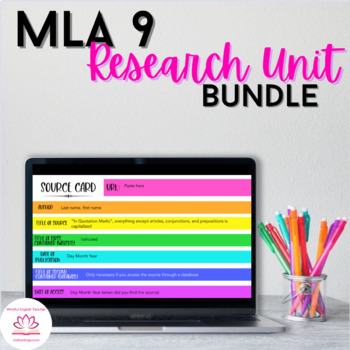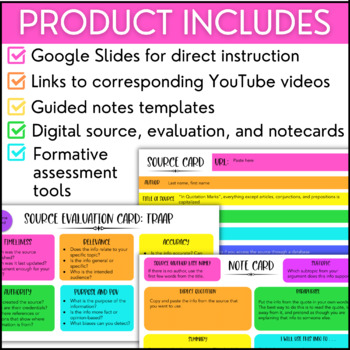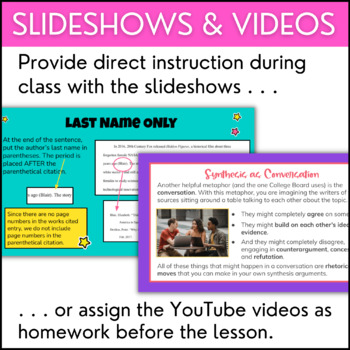MLA Research Resources for High School, Digital Lesson Bundle
- Google Drive™ folder

What educators are saying
Products in this Bundle (6)
showing 1-5 of 6 products
Description
This bundle of resources will help you teach all phases of the research process, from understanding the different types of sources to correctly citing research using MLA format. Everything reflects the most recent MLA guidelines (MLA 8 and 9 follow the same formatting rules.)
Research projects are often the most challenging part of the curriculum for both students and teachers. Perhaps now more than ever, students need to be able to find and evaluate sources—and that's only the beginning of what they must do to create a successful research project.
I suggest using the resources in the following order:
- Intro to research. After you have introduced the assignment, students need to begin conducting research. To do this, they need source literacy, which has become more challenging to teach with most sources being digital. This resource helps students develop this critical foundational skill—and will save you and your students from the aggravation that inevitably comes from not knowing enough about the different types of sources.
- MLA research source cards, note cards, and video library. This little resource packs a big punch in terms of content: it contains SIX instructional videos on various aspects of the research process, including evaluating sources. There are also videos that show students how to complete the notecards. (My own students OVERWHELMINGLY reported that these notecards were the most helpful part of the research process.)
- Argument graphic organizer. This Google slides graphic organizer was designed to help students with the two most difficult phases of the writing process: narrowing the scope of an argument and developing a clear structure that supports the thesis. Although this product was designed to help students who are writing research arguments, it is really about helping them organize any type of larger writing project, including guided questions that will help them narrow or broaden the scope of a topic as necessary.
- Integrating Sources Lesson. This video link, editable slideshow, guided notes, and group practice activity will prepare students to integrate source material effectively.
- Synthesis lesson. This video link, editable slideshow, guided notes, and practice activities the what, why, and how of synthesis.
- MLA in-text citations. After all of that work, who feels like teaching in-text citations? With this resource, you don't really have to. It includes a link to a comprehensive YouTube video that help students understand the guiding principles of MLA. The 7-page PDF corresponds precisely to the video and is intended for students to take notes on while they watch the video. They will then have this guide to refer back to when they are working on their research. You can also refer them back to it when you see they are having difficulty with any of the MLA guidelines.
These resources together will help you teach the research process more quickly and efficiently. They also—and this is my favorite part—make it really easy to reteach and differentiate because students can work at their own pace.





